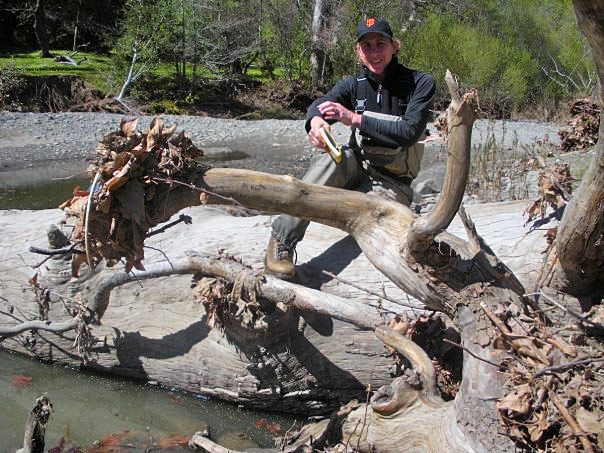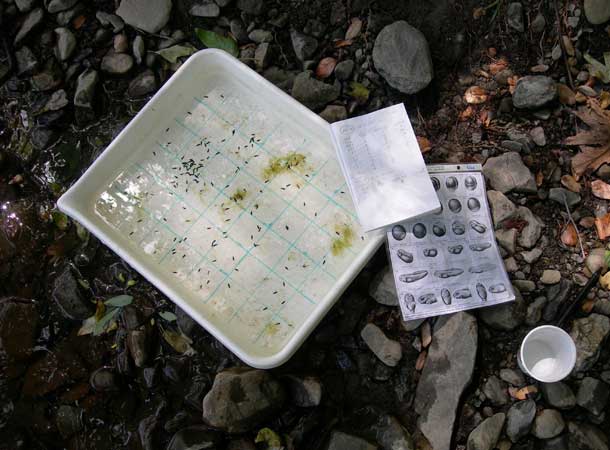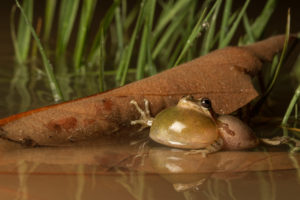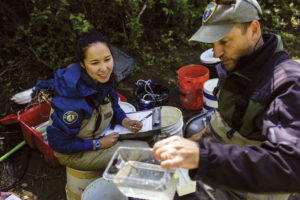Alameda Creek has a few claims to fame: It drains the second-largest watershed feeding San Francisco Bay. It covers a surprising variety of habitats from Sunol Wilderness through Niles Canyon all the way to the urban wilds of Fremont. And every year, determined activists try to help a few migrating steelhead trout find their way upriver.
But it’s the frogs that have fascinated Sarah Kupferberg, a research scientist at UC Berkeley. Alameda Creek used to have foothill yellow-legged frogs all along its length, but now they persist only in pockets and in scarce numbers. Kupferberg has been keeping an eye on them for a while, and her research will culminate with a forthcoming article in Copeia, the quarterly journal of the American Society of Ichthyologists and Herpetologists.
But even non-herpetophiles should take an interest in this locally rare frog, officially known as Rana boylii. They have disappeared from almost half of their historic habitat throughout California. “They live only in flowing water, which has become scarce due to water diversion for agriculture and hydroelectric power,” Kupferberg explains.
The frogs in Alameda Creek don’t know it, but there are big decisions being made right now that may determine their future: The San Francisco Public Utilities Commission (SFPUC) is about to replace the Calaveras Dam, currently an old rammed-earth structure, with a modern, more earthquake-safe dam. Decisions about the new flow regime are crucial, since the current dam is operating at only 30 to 40 percent of its actual capacity. The new, safer dam will be able to hold back a lot more water. The question, Kupferberg explains, is how much water to release and when to release it.
The decision could mean life or death for foothill yellow-legged frogs, whose populations downstream of the dam in Alameda Creek have crashed in recent years, compared to the populations upstream of the dam near Camp Ohlone. This change is due to poorly timed pulses of water during the late spring and summer; the increased water velocity either washes the tadpoles away or causes them to shelter under rocks where they are more likely to be eaten by predators such as dragon fly nymphs or giant water bugs.
Kupferberg has been working with Steve Bobzien, an Ecological Services Coordinator of the East Bay Regional Parks, on collecting population data regarding the breeding efforts of the foothill yellow-legged frogs, as well as other amphibians. Part of her research focuses on temperature and how it effects the development of tadpoles, which might help determine just how closely the needs of frogs and steelhead match. “Most of the temperature tolerance studies have been done on more northern populations [of steelhead], so people think they need really cold water,” she says. Water released from the dam is drawn from the bottom, where the temperature is much colder than the natural habitat of the frogs.
Kupferberg’s goal in conducting her research is to let advocacy groups as well as dam managers know about the current conditions. “I’m hoping that by getting more information about [the frogs], advocacy organizations can help them.”

- Alameda Creek flows through Sunol Regional Wilderness. Creative Commons photo by OutdoorPDK.
One of the key groups in this watershed is the Alameda Creek Alliance, led by Jeff Miller. This organization makes sure environmental concerns of the creek are heard, putting pressure on the SFPUC to adopt more conscientious practices. Kupferberg works with the SFPUC as well, with the aim of “providing them with information directly to try to improve management.”
SFPUC Ecosystem Stewardship Coordinator Ellen Natesan says her agency has definitely been influenced by Kupferberg’s work: “If she weren’t out there collecting all that data then we wouldn’t know. She has been extremely instrumental in shaping our policies.”
Those policies could well determine whether or not these frogs survive. Natesan says building a new dam is actually a good thing. The current dam was completed in 1925, predating the Endangered Species Act by almost 50 years. Having a new, more efficient dam will allow more flexibility. “Everyone is pretty excited to be doing things differently,” she says of her SFPUC colleagues. “We are going to be changing how we operate our water supply system.” It is her “desire and goal” to ensure that the frogs make a comeback.
In the past, the water flow releases were not consistent with natural timing. “The big concern,” explains Miller, “was the way the dam has been operated in the past. When they do release water, they tend to dump it all at once.” Twice in the past few years the SFPUC has released water from the reservoir at a rate of 400 cubic feet per second for a period of weeks. Natesan explains that these releases were made in order to abide by state restrictions for earthquake safety in place since 2001. Luckily, after what Miller describes as a 13-year battle, the management practices are changing. The unnatural water pulses are going to stop and less water will be released at any given time.
Debates over water management on Alameda Creek have raged for years, though the frogs have gotten a lot less press than steelhead trout. A major obstacle for the foothill yellow-legged frog, as compared to steelhead, is that it is not federally listed as an endangered species. Miller is also a conservation advocate at the nonprofit Center for Biological Diversity, and in that capacity, he’s been working on a petition to get the frogs listed.
But that’s easier said than done. The frog’s current status is “warranted but precluded” which, Kupferberg explains, means it should be listed but hasn’t been due to lack of funds. “It is state-listed as a species of special concern, but the state laws don’t have the same teeth as the Endangered Species Act,” she says, adding that “the threat of listing motivates utilities to do the right thing.”
Still, in the discussion of the new management of the dam, much of the talk has been about conditions suitable for steelhead, while “amphibians are taking a back seat,” says Kupferberg. Miller says he hopes the steelhead will act as “an indicator species–generally flow releases that are going to benefit steelhead are also going to benefit other native species.”
How this plays out remains to be seen. The dam is scheduled to be finished by 2015, but some policies regarding the flow regime are already starting to change.
For Kupferberg, there’s “a fine line between being a scientist and an advocate,” and she is straddling those roles. She understands that there is “a need for power, a need for water, a need for frogs.” And, she adds, the SFPUC has been “pretty responsive.” Miller says he’s glad that the water flows will soon “more closely mimic the natural hydrology” of the creek, changes that will be extremely beneficial to the native wildlife.
“Everyone is poised to work together,” says Kupferberg. “It’s a delicate balance.”

.jpg)





